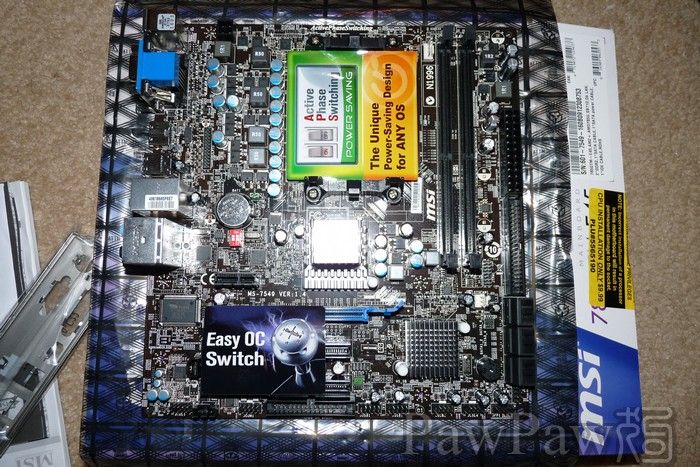

While the MSI board was not packaged as fancy as the XFX board, it does come with a printed manual! Besides the printed manual, there is also a quick installation guide; driver CD; a SATA cable; a SATA power adapter cable and an IDE cable.


On board, the MSI MB also has 6 SATA ports and unlike the XFX only has 4 of them active on default BIOS settings; all 6 SATA ports are active here. But equall bad as the XFX board, the SATA ports are also facing side rather than up. To make up for the short fall of USB ports compares to the XFX MB on the back panel, this MB has 4 two ports USB connectors on board compare to three on the XFX so the total max. Possible USB ports for both boards are 12 if one buys USB back or front panel brackets to bring the ports out. One thing not so great aboutthis board is it only has two memory slots but this is ok with me as I don't plan to use more than 4GB of memory any way. What is more important to me is this board at least has one IDE port that XFX lacks. This is important for the old IDE based HD DVD drive .
Installation
After the board is installed, updating the driver is quite easy as MSI has an on-line update utility that will check for the latest drivers and BIOS. Updating the BIOS is easy. This factor alone makes the MSI board a far better choice than the XFX.
The BIOS is able to unlock unused core from certain AMD CPUs. Of course, being able to unlock a locked core does not mean it will functon correctly. I tried on my X3 and it hangs which means the 4th core is really a bad one to begin with.
The on board video, ATI 4200 turn out to be somewhat disappointing. I first tried the board with an AMD Athlon 64 5200+ I have. The Windows 7’s Aero scores in a low 3.8. In comparison, the GeForce 9300 of the XFX MB with an Intel Core Duo E4300 that in general performs around the same as the AMD CPU gets a 4.7 Aero score. When I put in the AMD Athlon II X3 440, the Aero score still a low 4.3. Even when over clock t he ATI 4200 from 400MHz to 700MHz, the Aero still not able to compete with the GF9300 with an Aero score of 4.5. It is certainly a disappointing performance to say the least. Especially when the AMD 785 chipset is a newer chipset and it’s ATI 4200 graphics processor is AMD’s top IGP. Over clocking, at least for the on board video is easier and more stable than the XFX board.
Regardless of the Aero performance, the ATI 4200 is capable to playback both HD DVD or Blu-Ray video without any problem. HD audio on the other hand turn out to be very different story. The MSI’s web site somewhat imply this board supports HD audio. What they neglect to make it clear is that HD audio only means the on board Realtek’s audio chip supports 8 ch. analog output. The HDMI port on the other hand only supports two ch. stereo LPCM sounds.
HDMI Setup
After first boot up, the Windows 7 will install the default HDMI driver automatically. Unfortunately, the default Microsoft HDMI driver only supports 2ch audio. Furthermore, the MSI driver CD split the HDMI driver from the chipset driver and requires separate installation. Even after install the ATI HDMI driver from the CD, I still only got 2 ch. Audio. Upon further on-line search, I was dismayed to found out that the AMD 785 chipset only capable to support 2 ch. LPCM output. An updated Realtek HDMI driver on the Realtek’s web site allows pass through of none HD audio stream such as regular 5.1 ch. DD and DTS sound tracks. After download and install the Realtek HDMI driver however, I still only got 2 ch. PCM output. Its only looking into the matter further, I found out there is an option on the Windows Sound manager that need to be selected to support pass through of none LPCM sound tracks. There is NO documentation that I can find on either MSI, AMD or Realtek ‘s web sites to state very clearly what is supported and how to make best use of the on board HDMI connection!
Summary and Conclusion
Pro:
- The board is more stable than the XFX GeForce 9300 board before it.
- MSI has a much better support web site and on-line update driver update mechanism.
- There is a printed manual.
- Able to unlock unused core of AMD CPUs.
- Reasonably easy to over clock for the onboard ATI 4200.
- HDMI, DVDI and VGA video output.
- Total 12 USB and 6 SATA ports.
- HDMI only supports 2 ch. LPCM audio. Even with updated Realtek HDMI driver, it can only support pass though of older 5.1 ch. DD or DTS sound tracks. No HD audio.
- Only 2 memory slots.
- Only 4 USB ports on the back panel. One needs breakout brackets to bring out the rest.
- No SPDIF port on the back panel.
- Performance of the ATI 4200 even over clocked is no match to GeForce 9300.
For people who are happy with regular DD or DTS sound tracks, this is a good board for an all in one setup. If you want DTS HD MA or DD TrueHD however, you still require having an add-on graphics for that.
No comments:
Post a Comment